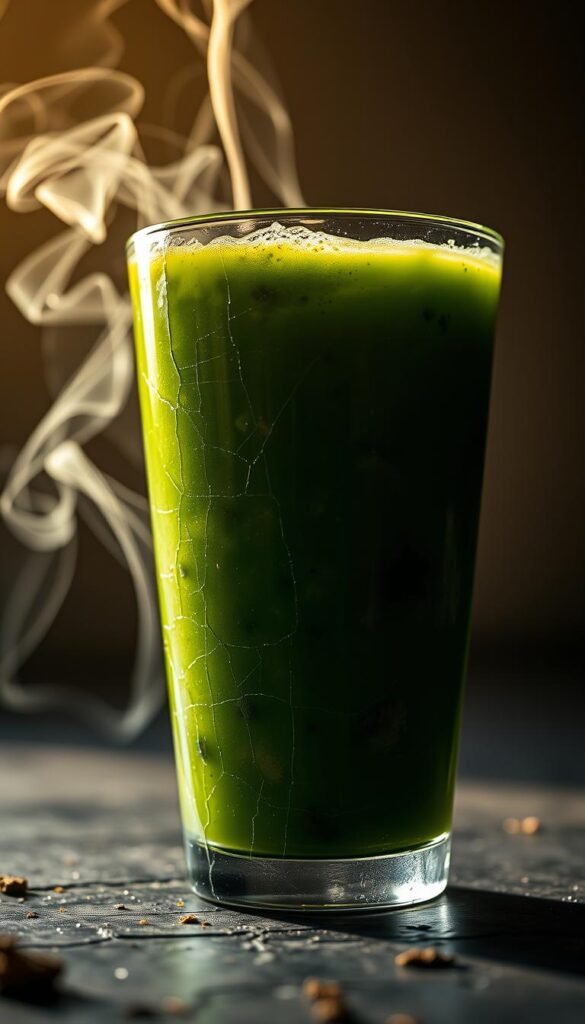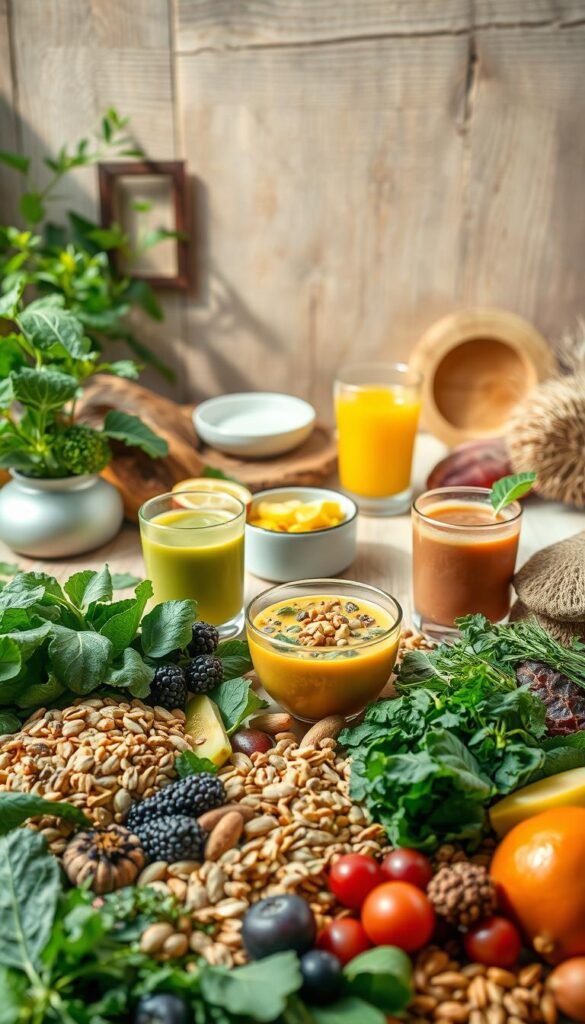In today’s fast-paced world, many seek ways to reset and recharge. Juice cleanses have emerged as a popular ritual, promising to nourish both the body and spirit. But what lies beneath the surface of this modern wellness trend?
While some view these cleanses as a spiritual detox, others question their scientific validity. The truth is, our bodies are naturally equipped to remove toxins. Yet, the idea of a “reset” can feel empowering, like a spring flood washing away debris.
However, it’s essential to approach this practice mindfully. Research shows that eliminating fiber and protein can disrupt the microbiome and cause blood sugar spikes. Balancing short-term purification goals with long-term health is key.
This article explores the tension between spiritual aspirations and physiological realities. Whether you’re a seasoned practitioner or a curious beginner, we’ll guide you toward a deeper understanding of how to harness the nutrients and wisdom of this practice.
Key Takeaways
- Juice cleanses are a popular way to reset both body and spirit.
- Our bodies naturally detox, but cleanses can feel empowering.
- Scientific evidence highlights potential risks like microbiome disruption.
- Mindful practice balances short-term goals with long-term health.
- This guide offers insights for both beginners and experienced practitioners.
Introduction to Juice Cleanses
The concept of cleansing has deep roots in both ancient traditions and modern practices. From fasting rituals in ancient cultures to the detoxifying trends of today, the desire to purify the body and mind has always been a part of human history. Modern juice cleanse practices often draw inspiration from these age-old traditions, blending them with contemporary wellness goals.
Typically, a cleanse involves a liquid diet lasting from one to seven days. Cold-pressed juices, lemon water, and herbal supplements are common components. These protocols aim to flood the body with nutrients from fruits vegetables while eliminating solid food groups. The idea is to give the digestive system a break and allow the body to focus on healing.
Psychologically, the appeal of a “clean slate” is undeniable. Many people feel a sense of renewal and symbolic purification after completing a cleanse. However, it’s important to remember that our bodies are already equipped to remove toxins. The liver and kidneys work tirelessly to filter and eliminate waste, making the need for external detoxification unnecessary.
UR Medicine emphasizes this point, stating, “If we held toxins, we wouldn’t survive.” This challenges the myth that cleanses are essential for detoxifying the body. Instead, they may offer a temporary reset, but they’re not a long-term solution for health.
There are also risks to consider. For example, a study by Makkapati highlights the danger of oxalate nephropathy from consuming excessive beet or spinach juices. This condition can lead to kidney damage, underscoring the importance of moderation and balance.
Despite the initial benefits, many people struggle to maintain the results of a cleanse. Research shows that 67% of participants relapse into their previous eating patterns. This raises questions about the sustainability of such practices and whether they truly support long-term health goals.
In essence, while a juice cleanse can feel empowering, it’s crucial to approach it with mindfulness. Understanding both its historical roots and modern implications helps us make informed decisions about our health and well-being.
Benefits of Juice Cleanses

Exploring the benefits of nutrient-rich liquids can reveal surprising insights into health and wellness. These practices are often praised for their ability to deliver concentrated vitamins and nutrients directly to your system. But what makes them so appealing, and how do they impact your body in the short and long term?
Nutrient-Rich Intake
One of the most significant advantages is the flood of nutrients from fruits and vegetables. Green juices, for example, are packed with phytonutrients that can support overall health. However, studies show that removing fiber during juicing can harm the gut microbiome, creating a paradoxical effect. While antioxidants increase, essential gut bacteria may suffer.
This “nutrient debt” concept highlights the trade-off between immediate benefits and long-term health. While juicing provides a quick boost of vitamins, it often sacrifices fiber, which is crucial for digestion and gut health.
Potential Weight Loss
Many people turn to these practices for weight loss. In the short term, glycogen depletion leads to water-weight reduction, which can feel encouraging. However, a 2017 review found that 89% of participants regained the weight after returning to their regular diet.
This raises questions about sustainability. While initial results may seem promising, the lack of solid food can lead to energy crashes and cravings, making it challenging to maintain progress.
Hydration and Kidney Function
Staying hydrated is essential for kidney health, and liquid diets can support this goal. However, excessive consumption of high-oxalate juices, like beet or spinach, can overload the kidneys and lead to complications. Balancing hydration with moderation is key to reaping the benefits without risking harm.
In summary, while these practices offer immediate advantages like nutrient density and hydration, they also come with trade-offs. Understanding these dynamics can help you make informed decisions about your health journey.
Risks and Drawbacks of Juice Cleanses

While the allure of quick health fixes is strong, it’s vital to understand the potential downsides. These practices, though popular, come with significant risks that can impact your body and mind. Let’s explore the challenges and why a balanced approach is essential.
Unsustainable Weight Loss
Many turn to these practices for rapid weight loss. While you may see initial results, they’re often short-lived. A 2017 review found that 89% of participants regained the weight after returning to their regular diet. This highlights the risks of relying on temporary solutions for long-term goals.
Low Blood Sugar and Malnutrition
One of the most immediate risks is the impact on blood sugar levels. Juice-only diets can cause spikes and crashes, leading to fatigue and dizziness. UR Medicine warns of hypoglycemia and fainting risks, especially for those with pre-existing conditions. Additionally, the lack of essential fats and proteins can lead to malnutrition, disrupting hormone production and overall health.
Impact on Gut Health
Your gut plays a crucial role in overall well-being, and these practices can harm it. A Northwestern study found that juice-only diets increase inflammation-linked bacteria while reducing beneficial gut bacteria by 40%. This imbalance can lead to conditions like leaky gut and even autoimmune disease. Without fiber, your digestive system struggles to maintain its natural balance.
| Risk | Impact | Prevention |
|---|---|---|
| Unsustainable Weight Loss | Weight regain after cleanse | Focus on long-term diet changes |
| Low Blood Sugar | Fatigue, dizziness, fainting | Monitor sugar intake, eat balanced meals |
| Gut Health Disruption | Reduced beneficial bacteria, inflammation | Include fiber-rich foods, probiotics |
Understanding these risks helps you make informed decisions. While the idea of a fresh start is appealing, it’s crucial to prioritize your long-term health over short-term gains.
Can Juice Cleanses Help in the Skin Detox Process?
Juice cleanses can play a role in the skin detox process by providing essential nutrients that promote hydration and eliminate toxins. Incorporating fresh juices into your diet may reveal hidden skin detox secrets, leading to a clearer, more radiant complexion. Nourishment from fruits and veggies supports overall skin health.
Alternatives to Juice Cleanses

Finding sustainable ways to nourish your body doesn’t require extreme measures. Instead of short-term fixes, consider approaches that support long-term nutrition and gut health. These alternatives focus on balance, variety, and moderation, helping you feel your best without the risks of restrictive diets.
Balanced Diet
A balanced diet rich in whole foods is one of the most effective ways to maintain health. UR Medicine emphasizes the importance of consuming a variety of fruits, vegetables, lean proteins, and healthy fats. This “rainbow plate” approach ensures you get a wide range of phytonutrients without eliminating essential food groups.
Dr. Ring suggests, “Pair juices with chia seeds to slow sugar absorption.” This simple tip can help stabilize blood sugar levels while still enjoying the benefits of nutrient-rich liquids.
Intermittent Fasting
Intermittent fasting, such as the 16:8 method, offers a structured way to give your digestive system a break. Unlike juice-only diets, this approach allows you to eat solid foods during your eating window. Studies show it can improve metabolic health and support weight management without the drawbacks of extreme calorie restriction.
Stockman’s research highlights the benefits of intermittent fasting over juice fasting, noting better sustainability and fewer side effects.
Plant-Based Diets
Adopting a plant-based diet can provide similar benefits to juice cleanses without the risks. Focus on whole, minimally processed foods like legumes, nuts, seeds, and grains. These foods are rich in fiber, which supports digestion and gut health.
Northwestern University recommends blending instead of juicing to retain fiber. For example, smoothies with apple skins and citrus pulp can provide a nutrient boost while keeping your digestive system healthy.
3-Day Sample Meal Plan
Here’s a simple meal plan to help you meet the daily 25g fiber target:
| Day | Meal | Food |
|---|---|---|
| Day 1 | Breakfast | Oatmeal with berries and chia seeds |
| Day 1 | Lunch | Quinoa salad with chickpeas and spinach |
| Day 1 | Dinner | Grilled salmon with roasted vegetables |
| Day 2 | Breakfast | Smoothie with kale, banana, and almond milk |
| Day 2 | Lunch | Lentil soup with whole-grain bread |
| Day 2 | Dinner | Stir-fried tofu with broccoli and brown rice |
| Day 3 | Breakfast | Avocado toast on whole-grain bread |
| Day 3 | Lunch | Chickpea and vegetable curry |
| Day 3 | Dinner | Baked sweet potato with black beans and salsa |
By focusing on these alternatives, you can achieve your health goals in a sustainable and enjoyable way. Remember, small, consistent changes often lead to the most lasting results.
Conclusion
Balancing spiritual aspirations with physical needs is key to lasting health. As experts from UR Medicine suggest, professional guidance ensures your diet supports both your body and mind. Instead of extreme measures, consider a “conscious hydration” ritual—replacing intense protocols with mindful practices.
Dr. Sardaro reminds us, “Nutrition isn’t subtraction—it’s wise addition.” This approach fosters self-compassion over punishment, helping you achieve wellness without sacrificing balance. For instance, monthly green smoothie days can be a gentler alternative to weekly cleanse routines.
If these practices trigger disordered eating, reach out to the SAMHSA helpline. As Gandhi wisely said, “Health requires balance, not extremism.” By integrating spiritual intentions with biological realities, you can nurture your body and soul in harmony.
